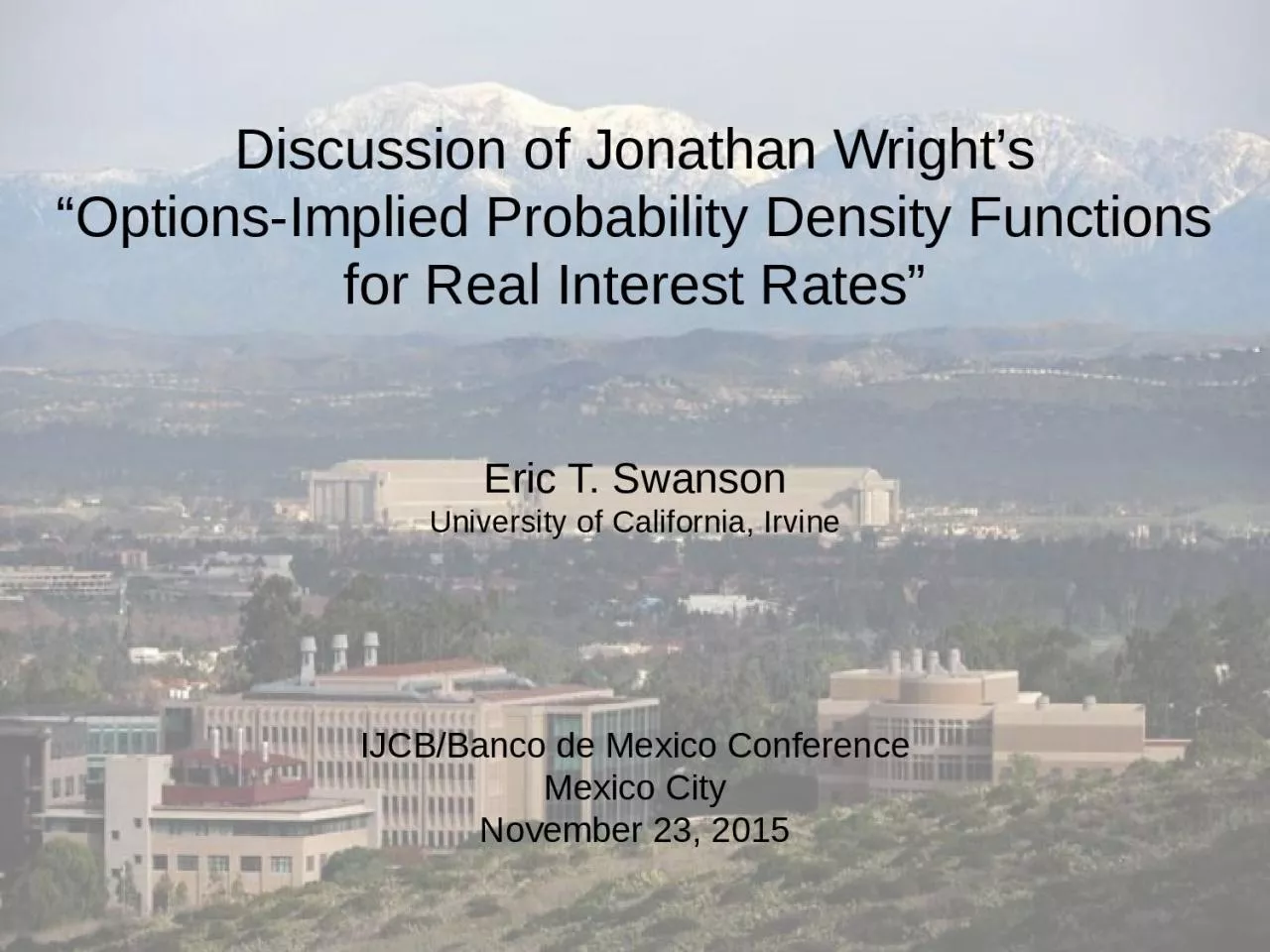

OptionsImplied Probability Density Functions for Real Interest Rates IJCBBanco de Mexico Conference Mexico City November 23 2015 Eric T Swanson University of California Irvine What the Paper Does ID: 1028854
Download Presentation The PPT/PDF document "Discussion of Jonathan Wright’s" is the property of its rightful owner. Permission is granted to download and print the materials on this web site for personal, non-commercial use only, and to display it on your personal computer provided you do not modify the materials and that you retain all copyright notices contained in the materials. By downloading content from our website, you accept the terms of this agreement.
1. Discussion of Jonathan Wright’s“Options-Implied Probability Density Functions for Real Interest Rates”IJCB/Banco de Mexico ConferenceMexico CityNovember 23, 2015Eric T. SwansonUniversity of California, Irvine
2. What the Paper DoesUse new data on TIPS options to compute implied probability distributions for real interest rates.
3. DifficultiesShort sampleOptions on TIPS began trading in January 2009Low volumeTotal trade volume is about 49 contracts/dayLarge bid/ask spreads (18%!)Even midpoints of bid/ask quotes have problems:Only available for about 10 strikes/dayThese 10 strikes are not well distributed (many are deep in the money), which makes them less informativeFinancial Crisis occupies a significant part of the sampleRisk premia large and variable
4. Financial CrisisTIPS-Treasury mispricing (Fleckenstein-Longstaff-Lustig 2014)
5. Comment #1: Data Are WeirdQuotes not available for nearly as many strikes as you’d expectQuotes that do exist are oddly distributed:Many quotes are for deep in-the-money strikesOnly 15% of quotes are for out-of-the-money strikesOnly about 2% of quotes are for strikes that are >10% out of the moneySeem to be very few puts early in sampleComment/Suggestion: Check with CBOE/data provider so we understand better what’s going on
6. How to Evaluate Implied PDFsLiterature on evaluating forecast densities (Diebold, Gunther, Tay, 1998; Berkowitz, 2001)Convert PDF to CDF, then map CDF to unit interval:
7. Results for TIPS Options-Implied PDFs
8. TIPS PDF Forecasts Were Biased UpwardOptions consistently over-predicted TIPS yieldsr = i – πSo options eitherover-predicted i, orunder-predicted π(Recall: predictions are for 7-year TIPS 3 or 6 months ahead)
9. Nominal U.S. Treasury Yields, 2009-2014source: Swanson and Williams (2014)
10. Blue Chip Forecasts of Time to First Tighteningsource: Swanson and Williams (2014)
11. Comment #2: Discuss Bias in Implied PDFsTest for biasDiscuss reasons for bias/nonuniformity:Risk premium?Or forecast errors?Currently, paper takes a strong position that it’s risk premiumBut there’s substantial evidence of nominal interest rate forecast errors during this period
12. Estimating Options-Implied PDFsTwo main approaches:1. Assume a parametric form for PDF and estimate parameters to fit observed options prices2. If options pricing function p(K) is known, can compute PDF for the underlying as d2p/dK2(In practice, p(K) is not known but must be estimated)
13. Parametric Form for PDFStep function is one common parametric form:Another common form is mixture of 2 or 3 normals (fewer parameters than step function)Implied PDF for Eurodollar rate 5 quarters ahead, 11/2/2011
14. Estimating Option-Pricing Function p(K)Assume options pricing function has formp(S,K,σ,d,τ,r)S = spot price of underlyingK = option strike priceσ = volatility (and higher moments of stochastic distribution)d = dividends from underlyingτ = time to expirationr = risk-free interest rate (nominal) from now to expirationCan estimate function p parametrically or nonparametrically
15. Estimating p ParametricallyTransform options prices to Black-Scholes implied volsFit quadratic or spline to implied vols to get smooth functionTransform implied vol function back to pricing function p(K)
16. TIPS Implied Volatility Smile
17. Sparse Data Can Be a ProblemBut 10 observations/day is not bad
18. Estimating p NonparametricallySparse data not normally a scenario for nonparametric estimationIdea: combine data from similar daysInstead of estimating p(K) on a single day, estimate p(S,K,σ,d,τ,r)nonparametrically over whole sampleLet σ be a function of state of economyCase 1: σ(S,K,τ)Case 2: σ(S/K,τ,σEGARCH)Case 1 problematic: averaging uncertainty over whole sample(uncertainty about real rates in 2009 same as in 2013)
19. Comment #3: Justify Nonparametric EstimationCase 1 is too crude—better to drop itCase 2 is reasonable, but requires the EGARCH model to be good to produce good results. It’s also very complicated.Parametric estimation is simpler, removes dependence on auxiliary model10 observations/day should be plenty to get a good implied volatility fit(Bliss-Panigirtzoglou (2002) had 10.8 strikes/day for short sterling futures, found parametric implied vol smile method worked very well)Need to justify nonparametric approach for these data
20. Comment #4: Standard Errors Seem Too SmallGiven data sparseness and giant bid-ask spreads, these standard error bands seem far too narrow
21. Summary of Comments and Suggestions Data are weird in a number of respectscheck with CBOE/data provider for insightsImplied PDFs were upward biasedrisk premium, or forecast errors?Justify nonparametric estimation methodparametric implied volatility smile an appealing alternativeStandard error bands around PDFs seem too narrow